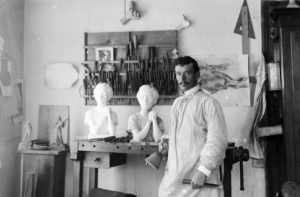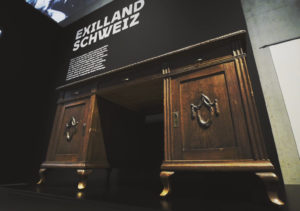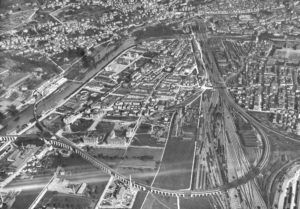
Swiss National Library
Switzerland from above
Eduard Spelterini was an adventurer, balloonist and photographic artist. He showed many for the first time what Switzerland looks like from above.
When Eduard Spelterini took to the skies in his balloon, it was a festive occasion for the masses, an adventure for the passengers, and an event for scientific endeavour. Bands played, food stalls did a brisk trade and thousands paid a decent admission fee to watch. They all wanted to see how the captain and his vehicle, as gigantic as it was short-lived, defied gravity and lifted off into the air. Around 1900, Spelterini was a star. He made the dream of flying come true.
But the famous captain’s origins were more beer froth than stardust: under the middle-class name Eduard Schweizer, Spelterini was born into a Toggenburg innkeeper’s family on 2 June 1852. Almost nothing is known about his childhood and adolescent years. What is certain, however, is that at the age of just 20 he succumbed to the allure of defying gravity, and left for Paris. In the capital of balloon flight, he gained his balloon pilot’s licence in 1877.
THE BALLOON RIDE BUSINESS
From then on he chose to go by the glamorous name of Spelterini, and began showing paying passengers the world from above. In 1887, he had a balloon of his own made: sewn from yellow silk, the ‘Urania’ had a capacity of 1,500 cubic meters of hydrogen. Aboard the ‘Urania’, he took to the skies above Paris and Moscow, London and Cairo, St Gallen and Geneva. Among his clientele were stout-hearted members of the ‘upper crust’, curious soldiers and intrepid scientists. It is reputed that as the balloon ascended, Spelterini would climb on to the rim of the basket and belt out an aria. When, at just the right moment, he later produced champagne and cold chops from a picnic basket, even the most anxious passengers must have thought they were in seventh heaven.
But each ascent also meant a division. A select few soared to the heights, while the great mass of the public was left behind on the ground. They were denied the wonder of a bird’s eye view. Perhaps it was this regrettable circumstance that was the cause? In any case, after 1890 Spelterini discovered a new market: he started taking photographs from the air. To get his shots, he would hang over the edge of the basket with a heavy, clunky camera, at high altitudes and in low temperatures. Aerial photography was a complex and dangerous business. Nevertheless, Spelterini took breath-taking photographs. He gave numerous talks presenting his photos – and showed a wider public, for the first time, what the world looked like from above.
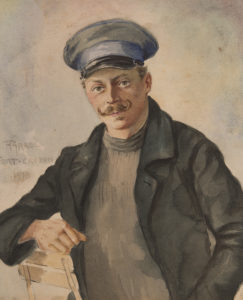
Hand-drawn portrait of Eduard Spelterini, around 1918.
Swiss National Museum

In 1904, Spelterini set off on his fourth Alpine flight from Eigergletscher station.
Swiss National Museum
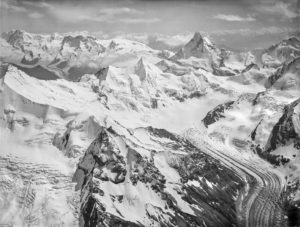
Spelterini’s spectacular view of the Valais Alps, 1910.
Swiss National Library
On 3 October 1898, accompanied by two scientists and an assistant, Spelterini lifted off from Sion. Via Les Diablerets and Yverdon, the wind drove the balloon as far as Rivière-les-Fosses in France. This made Spelterini the first person to overfly a high-altitude mountain range. Nine more Alpine crossings followed. As the 20th century dawned, Spelterini was at the height of his fame.

Longitudinal profile of the first flight over the Alps.
From: Albert Heim, Julius Maurer & Eduard Spelterini, Flight of the ‘Wega’ across the Alps and the Jura on 3 October 1898, Basel 1899
The fall, when it came, was all the harder: in 1914, international business collapsed. Borders closed. The paying passengers disappeared into the trenches and cemeteries of the First World War. For balloon pilots, the howling in the skies over Europe was an added portent of doom. The new aircraft were navigable to an accurate degree. And they could be steered against the wind. The balloon pilots could not compete with that. Suddenly, they found themselves on the scrap heap. The money and the hearts of the public were now flying to the young bomber pilots in their leather jackets. After the war, Spelterini did go up a few more times. In 1922, he spent a season offering balloon rides at Copenhagen’s Tivoli amusement park. But the inexorable rise of powered aviation was unchallengeable. For the balloonists, the show was over.
In 1923, Spelterini moved to a small farm in Upper Austria, where he and his family lived off the sale of eggs. The captain died on 16 June 1931, largely forgotten by the public. His pictures have remained. Today, we use satellite images for navigation on a daily basis, and anyone can take spectacular aerial photographs with a drone. But Spelterini's photographs still captivate – perhaps because they arouse two conflicting desires: the yearning for the tranquillity of balloon flight, and the quest for the spirit of adventure.
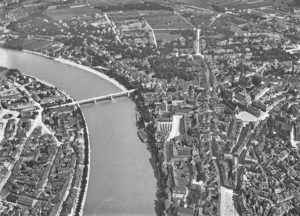
Basel from above.
Swiss National Library
From above – Spelterini’s balloon and the drone
SWISS NATIONAL LIBRARY
until 28 June 2019
In the exhibition ‘From above – Spelterini’s balloon and the drone’ the National Library in Bern tells a little story about aerial photography in Switzerland. From Eduard Spelterini’s balloon, the story proceeds through carrier pigeons, aeroplanes and satellites right up to the drone of today. The view from above creates knowledge of landscapes and technologies, and reveals the hidden gems in our surroundings. With a virtual reality balloon flight and photographing by drone, the exhibition invites visitors to change their perspective and explore the freshness and relevance of aerial photography.


